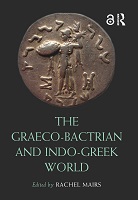Chapter 17 Greek inscriptions and documentary texts and the Graeco-Roman historical tradition
Proposal review
| dc.contributor.author | Mairs, Rachel | |
| dc.date.accessioned | 2023-09-12T12:05:59Z | |
| dc.date.available | 2023-09-12T12:05:59Z | |
| dc.date.issued | 2021 | |
| dc.identifier.uri | https://library.oapen.org/handle/20.500.12657/76201 | |
| dc.description.abstract | This chapters explores how three philological traditions Graeco-Roman, South Asian and Chinese have been and can be used to contribute to our understanding of Central Asia in the Hellenistic period. It outlines the current state of the written evidence in Greek and Latin – including both texts from excavated contexts and those from the manuscript tradition – to explore how this evidence has traditionally been used to interpret the history and culture of Hellenistic Central Asia, and to offer some prospective avenues for future research. The most convenient place to consult the Greek texts from Hellenistic Central Asia is in Rougemont’s volume in the series Corpus Inscriptionum Iranicarum. The presence of Greek inscriptions and administrative documents obviously cannot be taken as a proxy for the use of Greek as a spoken language of communication. | en_US |
| dc.language | English | en_US |
| dc.subject.other | Bactrian, Graeco, Greek, Indo, World | en_US |
| dc.title | Chapter 17 Greek inscriptions and documentary texts and the Graeco-Roman historical tradition | en_US |
| dc.type | chapter | |
| oapen.identifier.doi | 10.4324/9781315108513-21 | en_US |
| oapen.relation.isPublishedBy | 7b3c7b10-5b1e-40b3-860e-c6dd5197f0bb | en_US |
| oapen.relation.isPartOfBook | e708341a-672a-4806-ac54-a14c246632dd | en_US |
| oapen.relation.isFundedBy | fb471c48-61d1-40b5-a8d7-7abd9278f351 | en_US |
| oapen.relation.isbn | 9781138090699 | en_US |
| oapen.relation.isbn | 9780367550271 | en_US |
| oapen.imprint | Routledge | en_US |
| oapen.pages | 12 | en_US |
| peerreview.anonymity | Single-anonymised | |
| peerreview.id | bc80075c-96cc-4740-a9f3-a234bc2598f1 | |
| peerreview.open.review | No | |
| peerreview.publish.responsibility | Publisher | |
| peerreview.review.stage | Pre-publication | |
| peerreview.review.type | Proposal | |
| peerreview.reviewer.type | Internal editor | |
| peerreview.reviewer.type | External peer reviewer | |
| peerreview.title | Proposal review | |
| oapen.review.comments | Taylor & Francis open access titles are reviewed as a minimum at proposal stage by at least two external peer reviewers and an internal editor (additional reviews may be sought and additional content reviewed as required). |

